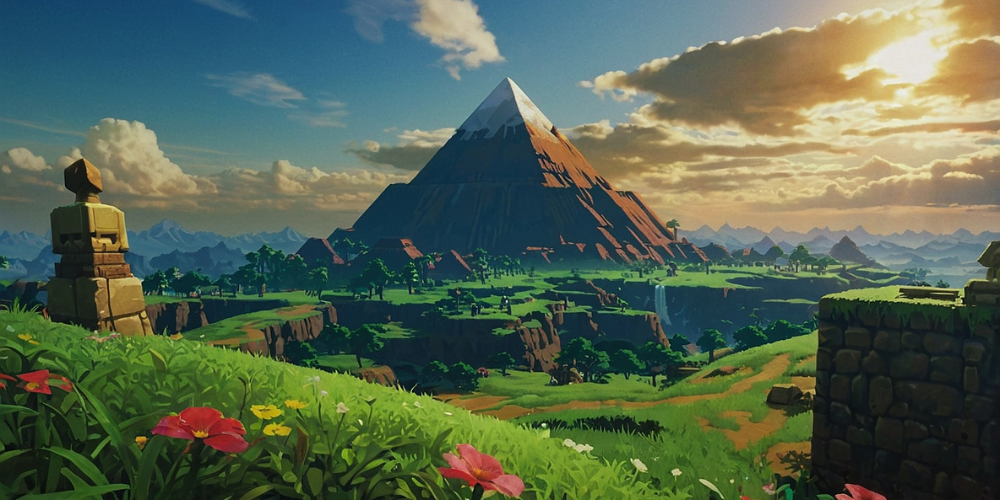The Evolution of The Legend of Zelda: From 8-Bit Beginnings to Open World Adventures
2024-12-30

As I sit down to relive the adventures from one of the most iconic franchises in gaming history, I can’t help but feel an overwhelming sense of nostalgia. The Legend of Zelda, a series that began its journey on the 8-bit Nintendo Entertainment System, has captivated generations of gamers, and I’m proud to be one of them. Picking up the controller for the first time, I was introduced to a world filled with mystery, exploration, and heroic quests.
My First Encounter: The Original Legend of Zelda
When I first laid eyes on the original Legend of Zelda in 1986, it was like stepping into another realm. Each pixelated map and simplistic character design conveyed a story ripe for exploration. The open gameplay format was revolutionary; I could tackle dungeons in non-linear order, finding random secrets and battling enemies in a world that felt alive. I remember the weight of my decisions, wandering through Hyrule with a wooden sword, encountering treacherous foes, and solving intricate puzzles—all while immersing myself in a captivating narrative.
The Transition to 16-Bit: A Link to the Past
Fast forward to 1991, and I found myself entranced by A Link to the Past on the Super Nintendo. The richer graphics were a feast for the eyes, and the music had a haunting quality that stuck with me. The overhead perspective made navigation much more intuitive, and the introduction of the parallel world system allowed me to explore alternate versions of the world I loved. Puzzles became more complex, while the storytelling deepened, bringing emotional resonance to the adventures of Link and Princess Zelda.
Venturing into the Third Dimension: Ocarina of Time
With the arrival of the Nintendo 64 in 1998, I was introduced to a groundbreaking era for games with Ocarina of Time. This was my first experience in a truly 3D environment. No longer constrained to top-down views, I was now navigating intricate landscapes and epic battles in full 3D glory. The N64’s controller felt like an extension of myself as I wielded the Master Sword against the unforgiving forces of evil. The introduction of the lock-on targeting system, Z-targeting, revolutionized combat, allowing me to focus on enemies with strategic precision. The emotional weight of the narrative, combined with time travel mechanics, left an indelible mark on my gaming soul.
Mastering Time and Space: The Legend of Zelda: Majora's Mask
Majora's Mask, released in 2000, took me on a darker, more introspective journey. The three-day cycle added an element of urgency, forcing me to plan my actions meticulously. Faced with the impending doom of the moon crashing into the world of Termina, I had to engage with the inhabitants, learn their stories, and manipulate time itself to prevent catastrophe. The creepy atmosphere, combined with profound themes of loss and redemption, made this entry unforgettable. It was the first time I grappled with the concept of consequence in a game.
Return to Form: The Legend of Zelda: The Wind Waker
Upon transitioning to the GameCube, I was greeted with a completely different artistic style in The Wind Waker. The cell-shaded graphics felt like stepping into a living cartoon. Setting sail across the Great Sea felt liberating, and I was excited by the freedom to explore uncharted islands. The quest for the Triforce while navigating changing weather patterns and engaging in epic pirate battles added layers of excitement. The emotional depth of the storyline—especially the relationship between Link and Tetra—resonated with me in ways I had not anticipated.
A Renaissance of the Classic: The Legend of Zelda: Twilight Princess
Twilight Princess, released in 2006, marked a return to the more mature and darker tones that I craved. The duality of Link's wolf form combined with his human identity introduced unique gameplay mechanics. The atmosphere was rich and moody, and the story deeper than its predecessors, tackling themes like sacrifice and the struggle against darkness. My encounters with the enigmatic Zoras, Gorons, and the enigmatic Midna added layers of complexity to my experience as I traversed through the beautiful yet haunting landscapes.
Exploring New Realms: The Legend of Zelda: Skyward Sword
In 2011, I was transported to the origins of the Zelda legend with Skyward Sword. The Wii’s motion controls allowed me to swing my sword in tandem with Link's movements and engage in immersive combat. I reveled in the puzzle-filled environments, deepening my understanding of both the gameplay and the lore behind Hyrule's origin. The art style reminded me of a beautiful painting, adding to the game's magic and allure. The story of love, courage, and the struggle against evil felt fresh and invigorating.
The 3D Reinvention: The Legend of Zelda: A Link Between Worlds
A Link Between Worlds, released in 2013, tasked me with solving puzzles in a familiar world that had evolved since A Link to the Past. The introduction of the wall mechanic provided a fascinating twist on traditional dungeon layouts, allowing for innovative gameplay that had me constantly thinking outside the box. My journey through Hyrule and Lorule embodied a sense of nostalgia mixed with newfound excitement, allowing me to rediscover old favorites while pursuing new challenges.
The Wait is Over: The Legend of Zelda: Breath of the Wild
In 2017, Breath of the Wild shattered all expectations and redefined what an open-world experience could be. The sprawling landscapes, diverse environments, and countless quests offered me an unprecedented level of freedom. I camped, cooked, and explored every mountain peak and waterfall at my own pace. The physics engine allowed me to approach challenges creatively, leading to extraordinary moments—from experimenting with elemental interactions to finding alternative solutions to puzzles. The gravity of the story, tied to ancient traditions of Hyrule, made each encounter deeper, more meaningful, and personal.
Revisiting the Classics: The Legend of Zelda: Link's Awakening
When Link's Awakening received a stunning remake in 2019, I felt drawn back to the whimsical charm of Koholint Island. The new art style breathed fresh life into the classic narrative. While its core story remained intact, the added polish made revisiting it an entirely new experience. With revamped graphics, beautiful music, and thoughtful quality-of-life improvements, I was reminded of how impactful the series has been through the years. Collecting instrument pieces to awaken the Wind Fish became an engaging quest that was as enchanting as I remembered.
Returning to the Joys of the Past: The Legend of Zelda: Skyward Sword HD
The remaster of Skyward Sword in 2021 allowed me to revisit the origins of the series with enhanced visuals and improved controls. This fresh take on the game rekindled my appreciation for the rich lore that fuels the franchise. The ability to experience the beautiful landscapes of Skyloft in higher definition made the iconic moments even more gripping. As I re-balanced my sword in critical battles, I rediscovered how the game laid the groundwork for many mechanics present in later installments.
The Future is Bright: Anticipating the Next Chapter
With rumors swirling and anticipation building, I eagerly await the next entry in the Legend of Zelda series. Each installment of this franchise has taken us on memorable journeys across time, dimension, and artistry. The evolution I have witnessed—from pixelated beginnings to sprawling open-world experiences—has shaped not only my love for gaming but also my appreciation for storytelling in interactive forms. I find myself reminiscing about my adventures with Link as I await the next chapter in his storied legacy.
Community and Culture: The Lasting Impact of The Legend of Zelda
Beyond the games themselves, the cultural impact of The Legend of Zelda is undeniable. Engaging with fellow fans through online communities, navigating fan art, and discussing theories surrounding the ongoing lore has become a cherished activity. The soundtracks composed by Koji Kondo evoke deep emotions, often popping into my mind as I navigate daily life. The influence of the series is felt across various media, from art and literature to music and cosplay, creating a vibrant culture that ensures the legacy of Hyrule lives on.
Looking Back: Personal Reflections on Growth Through Gameplay
As I reflect on my journey through the realm of Hyrule, I can’t help but recognize the profound personal growth I've experienced through gaming. Each adventure has taught me patience, perseverance, and creativity, leaving indelible marks on my identity as a gamer and storyteller. The lessons embedded within the puzzles and characters I’ve encountered encourage me to embrace challenges and seek out adventures beyond the screen.
Final Thoughts on Hyrule and the Legend of Zelda Legacy
The evolution of The Legend of Zelda is not merely a story of technological leaps but also a testament to the power of imagination and craftsmanship in video games. It has turned my gaming experiences into cherished memories filled with adventure and wonderment. As I continue to dive into this fantastical world, I know that Link’s journey is far from over.






